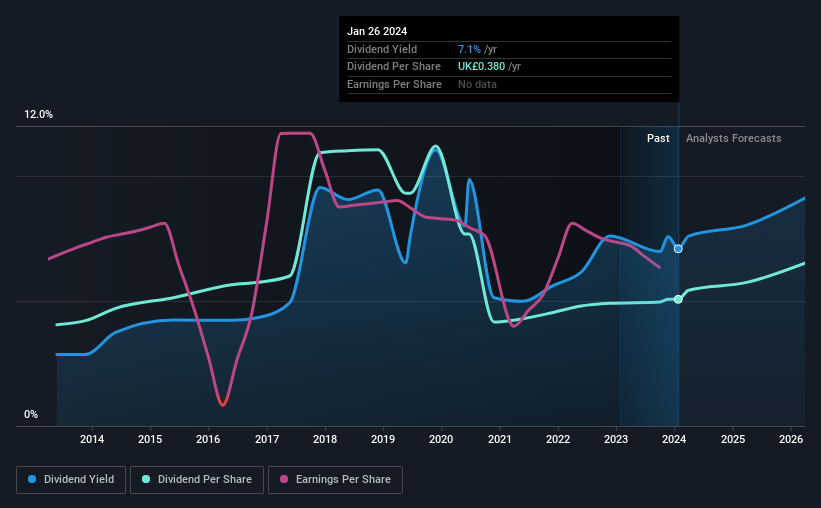Do These 3 Checks Before Buying PayPoint plc (LON:PAY) For Its Upcoming Dividend
PayPoint plc (LON:PAY) stock is about to trade ex-dividend in four days. The ex-dividend date is usually set to be one business day before the record date which is the cut-off date on which you must be present on the company's books as a shareholder in order to receive the dividend. The ex-dividend date is of consequence because whenever a stock is bought or sold, the trade takes at least two business day to settle. Meaning, you will need to purchase PayPoint's shares before the 1st of February to receive the dividend, which will be paid on the 5th of March.
The company's next dividend payment will be UK£0.095 per share, and in the last 12 months, the company paid a total of UK£0.37 per share. Based on the last year's worth of payments, PayPoint has a trailing yield of 7.1% on the current stock price of UK£5.36. If you buy this business for its dividend, you should have an idea of whether PayPoint's dividend is reliable and sustainable. So we need to check whether the dividend payments are covered, and if earnings are growing.
Check out our latest analysis for PayPoint
If a company pays out more in dividends than it earned, then the dividend might become unsustainable - hardly an ideal situation. It paid out 88% of its earnings as dividends last year, which is not unreasonable, but limits reinvestment in the business and leaves the dividend vulnerable to a business downturn. We'd be worried about the risk of a drop in earnings.
When a company paid out less in dividends than it earned in profit, this generally suggests its dividend is affordable. The lower the % of its profit that it pays out, the greater the margin of safety for the dividend if the business enters a downturn.
Click here to see the company's payout ratio, plus analyst estimates of its future dividends.
Have Earnings And Dividends Been Growing?
Companies with falling earnings are riskier for dividend shareholders. If earnings decline and the company is forced to cut its dividend, investors could watch the value of their investment go up in smoke. Readers will understand then, why we're concerned to see PayPoint's earnings per share have dropped 7.7% a year over the past five years. When earnings per share fall, the maximum amount of dividends that can be paid also falls.
Many investors will assess a company's dividend performance by evaluating how much the dividend payments have changed over time. PayPoint has delivered an average of 2.3% per year annual increase in its dividend, based on the past 10 years of dividend payments. The only way to pay higher dividends when earnings are shrinking is either to pay out a larger percentage of profits, spend cash from the balance sheet, or borrow the money. PayPoint is already paying out 88% of its profits, and with shrinking earnings we think it's unlikely that this dividend will grow quickly in the future.
To Sum It Up
Is PayPoint an attractive dividend stock, or better left on the shelf? Earnings per share have been declining and the company is paying out more than half its profits to shareholders; not an enticing combination. All things considered, we're not optimistic about its dividend prospects, and would be inclined to leave it on the shelf for now.
With that being said, if you're still considering PayPoint as an investment, you'll find it beneficial to know what risks this stock is facing. To help with this, we've discovered 5 warning signs for PayPoint (1 is significant!) that you ought to be aware of before buying the shares.
A common investing mistake is buying the first interesting stock you see. Here you can find a full list of high-yield dividend stocks.
Have feedback on this article? Concerned about the content? Get in touch with us directly. Alternatively, email editorial-team (at) simplywallst.com.
This article by Simply Wall St is general in nature. We provide commentary based on historical data and analyst forecasts only using an unbiased methodology and our articles are not intended to be financial advice. It does not constitute a recommendation to buy or sell any stock, and does not take account of your objectives, or your financial situation. We aim to bring you long-term focused analysis driven by fundamental data. Note that our analysis may not factor in the latest price-sensitive company announcements or qualitative material. Simply Wall St has no position in any stocks mentioned.

 Yahoo Finance
Yahoo Finance 
